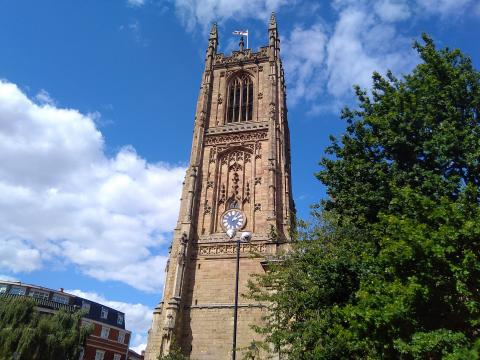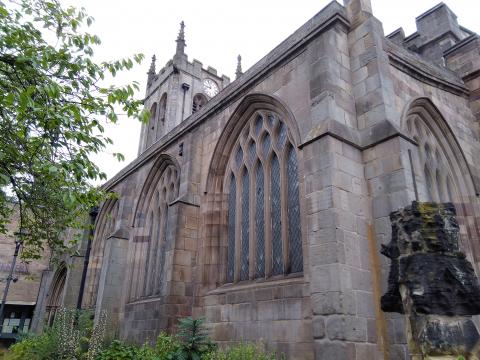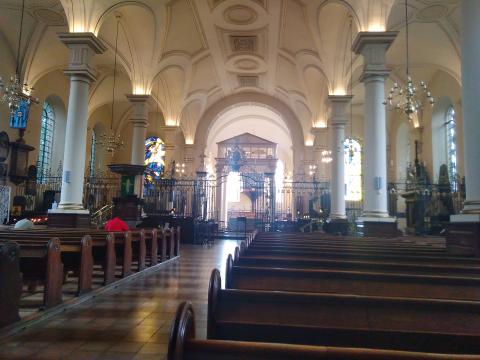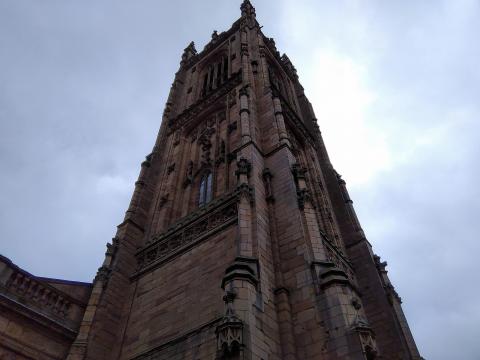Joan No Waste

I called at Derby Cathedral this summer. It was here that poor Joan Waste, a 22-year-old blind woman, was tried for her life. Her crime? She owned a copy of the New Testament, and would pay neighbours a penny a time to read it to her. When examined by the Bishop of Lichfield and his chancellor, it was also found that she did not believe in transubstantiation (that the wafter and wine of communion literally morph into Jesus’ flesh and blood) and that she preferred services in English, not Latin. For these heinous and horrid crimes, she was condemned to be hung over a fire by ropes, until she was consumed. Just before her fire was lit, she was compelled to hear a sermon preached against her at All Saints Church (now the cathedral, above) which was also the scene of her 'trial'.

We know little of her conversion, but we do know she attended nearby St Peter’s Church (above) where, before the time of Bloody Mary, the service was in English instead of the Latin, which poor Joan, a rope-maker and daughter of a town barber, would not have understood.
She held her twin brother’s hand and she walked to the town pit shere her painful and grisly execution would take place. Does not the picture of a blind lass being led to her death for the love of Jesus move you to tears? It did me. Ironically, the pit in which poor Joan died is now the site of a Catholic church, while the grand parish church in which she was tried is a protestant one. Its great tower (top and bottom pictures) Joan’s contemporaries would have recognised, for having been built only twenty years before her trial. The nave and chancel, however, are rebuilt in classical Georgian, with large, airy windows, an aesthetic move away from the dark age of Romanism from which Joan’s life was demanded.

John Foxe in his Book of Martyrs, writes:
This poor, honest woman, blind from her birth, and unmarried, aged twenty-two, was of the parish of Allhallows, Derby. Her father was a barber, and also made ropes for a living: in which she assisted him, and also learned to knit several articles of apparel. Refusing to communicate with those who maintained doctrines contrary to those she had learned in the days of the pious Edward, she was called before Dr. Draicot, the chancellor of Bishop Blaine, and Peter Finch, official of Derby.
With sophisitcal arguments and threats they endeavored to confound the poor girl; but she proffered to yield to the bishop's doctrine, if he would answer for her at the Day of Judgment, (as pious Dr. Taylor had done in his sermons) that his belief of the real presence of the Sacrament was true. The bishop at first answered that he would; but Dr. Draicot reminding him that he might not in any way answer for a heretic, he withdrew his confirmation of his own tenets; and she replied that if their consciences would not permit them to answer at God's bar for that truth they wished her to subscribe to, she would answer no more questions. Sentence was then adjudged, and Dr. Draicot appointed to preach her condemned sermon, which took place August 1, 1556, the day of her martyrdom. His fulminating discourse being finished, the poor, sightless object was taken to a place called Windmill Pit, near the town, where she for a time held her brother by the hand, and then prepared herself for the fire, calling upon the pitying multitude to pray with her, and upon Christ to have mercy upon her, until the glorious light of the everlasting Sun of righteousness beamed upon her departed spirit.

- Log in to post comments


 Sunday Worship 10.45am & 6.00pm
Sunday Worship 10.45am & 6.00pm